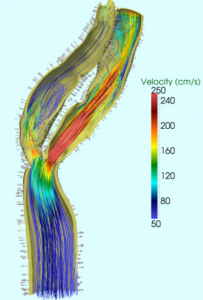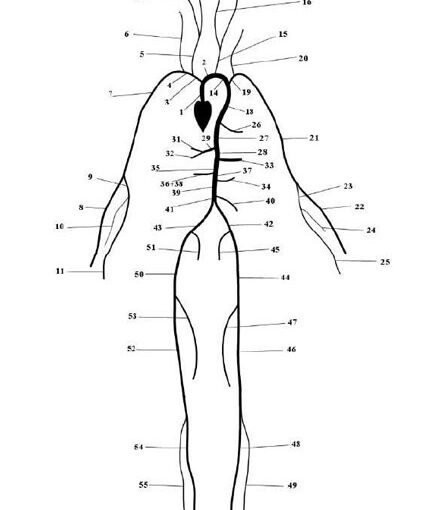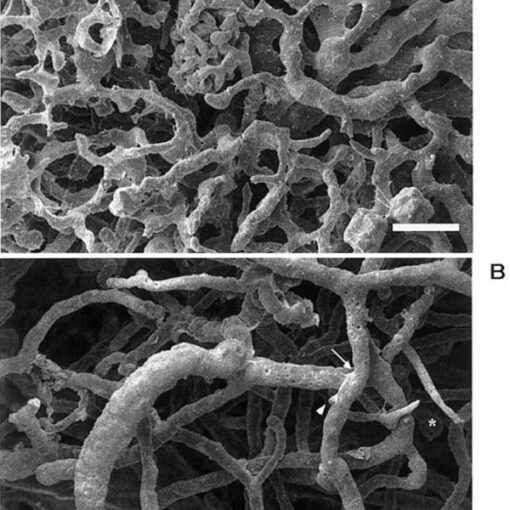
The interaction between the blood and the deformable artery leads to a very complex coupled problem
The solution of this fluid-structure interaction problem has been addressed by means of partitioned algorithms, whose convergence properties are in general very poor due to the high added mass effect characterizing the haemodynamic regime.
A theoretical analysis of the classical Dirichlet-Neumann scheme highlighted the instability of an explicit algorithm and the slowness of an implicit one. To improve the convergence rate Robin-type interface conditions have been studied. With a suitable choice of the interface parameters (based on the Optimized Schwarz Method), the convergence is quite independent of the added-mass effect
A different class of partitioned algorithms is derived by an algebraic fractional step method, leading to semi-implicit algorithms, where the geometrical problem is solved not exactly. In view of the applications to real clinical problems, semi-implicit algorithms have been extended to the case of non-linear models of elasticity for the vessel, obtaining efficient and accurate partitioned algorithms
A completely different approach consists in the monolithic schemes where suitable global preconditioners have been studied in view of an efficient parallel solution
We mention also the research on reduced models, where the structure is modelled as a membrane leading to simplified FSI problems involving only the fluid problem with suitable boundary conditions, and that on parameter estimation in FSI problems


Publications:
- S. Deparis, M. Fernandez, L. Formaggia, and F. Nobile, Modified fixed point algorithm in fluid-structure interaction, C.R. Mecanique, 331, pp. 525–530, 2003.
- Causin P., Gerbeau J.F., Nobile F., Added-mass effect in the design of partitioned algorithms for fluid–structure problems, Comp. Meth. Appl. Meth. Eng., 194(42-44), pp. 4506-4527, 2005
- S. Deparis, M. Discacciati, G. Fourestey, A. Quarteroni, Fluid-structure algorithms based on Steklov-Poincaré operators, Computer Methods in Applied Mechanics and Engineering, 195(41-43), pp. 5797-812, 2006
- A. Quaini, A. Quarteroni, A semi-implicit approach for fluid-structure interaction based on an algebraic fractional step method, Mathematical Models and Methods in Applied Sciences, 17(6), pp. 957-983, 2007
- Nobile F., Vergara C., An effective fluid-structure interaction formulation for vascular dynamics by generalized Robin conditions, SIAM J. Sc. Comp., 30(2), pp. 731-763, 2008
- Badia S., Nobile F., Vergara C., Fluid-structure partitioned procedures based on Robin transmission conditions, J. Comp. Phys., 227, pp. 7027-7051, 2008
- S. Badia, A. Quaini, A. Quarteroni, Splitting methods based on algebraic factorization for fluid-structure interaction, SIAM Journal on Scientific Computing, 30(4), pp. 1778-1805, 2008
- S. Badia, A. Quaini, A. Quarteroni, Modular vs. non-modular preconditioners for fluid-structure systems with large added-mass effect, Computer Methods in Applied Mechanics and Engineering, 197(49-50), pp. 4216-4232, 2008
- Badia S., Nobile F., Vergara C., Robin-Robin preconditioned Krylov methods for fluid-structure interaction problems . Comp. Meth. Appl. Mech. Eng., 198 (33-36), pp. 2768-2784, 2009
- S. Badia, A. Quaini, A. Quarteroni, Coupling Biot and Navier-Stokes equations for modelling fluid-poroelastic media interaction, Journal Of Computational Physics, 228, pp. 7986-8014, 2009
- F. Nobile, Coupling strategies for the numerical simulation of blood
ow in deformable arteries by 3D and 1D models, Mathematical and Computer Modelling, 49(11-12), pp. 2152–2160, 2009. - Formaggia L., Veneziani A., Vergara C., Flow rate boundary problems for an incompressible fluid in deformable domains: formulations and solution methods . Comp. Meth. Appl. Mech. Eng., 199 (9-12), pp. 677-688, 2010
- Gerardo-Giorda L., Nobile F., Vergara C., Analysis and optimization of Robin-Robin partitioned procedures in fluid-structure interaction problems. SIAM J. Num. Anal. , 48(6), pp. 2091-2116, 2010
- P. Crosetto, S. Deparis, G. Fourestey, A. Quarteroni, Parallel Algorithms for Fluid-Structure Interaction Problems in Haemodynamics, Siam Journal on Scientific Computing, 33(4), pp. 1598-1622, 2011
- Perego M., Veneziani A., Vergara C., A variational approach for estimating the compliance of the cardiovascular tissue: An Inverse fluid-structure interaction problem. SIAM J. Sc. Comp, 33(3), pp. 1181-1211, 2011
- P. Crosetto, P. Reymond, S. Deparis, D. Kontaxakis, N. Stergiopulos, A. Quarteroni, Fluid Structure Interaction Simulations of Physiological Blood Flow in the Aorta, Computers and Fluids, 43(1), pp. 46-57, 2011
- F. Nobile, C. Vergara, Partitioned algorithms for fluid-structure interaction problems in haemodynamics. Milan Journal of Mathematics, 80(2), pp. 443-467, 2012
- Pozzoli M., Vergara C., Nobile F. Efficient algorithms for the solution of fluid-structure interaction problems inhaemodynamic applications, Proceedings of the Conference “Numerical Methods for Hyperbolic EquationsTheory and Applications”, Santiago de Compostela, pp. 355-364, 2012
- T. M. Lassila, A. Quarteroni and G. Rozza. A reduced basis model with parametric coupling for fluid-structure interaction problems, Siam Journal on Scientific Computing, 34, pp. A1187 – A1213, 2012
- F. Nobile, M. Pozzoli, C. Vergara, Time accurate partitioned algorithms for the solution of fluid-structure interaction problems in haemodynamics. Computer and Fluids, 86, pp. 470-482, 2013
- F. Nobile, M. Pozzoli, C. Vergara, Inexact accurate partitioned algorithms for fluid-structure interaction problems with finite elasticity in haemodynamics. Journal of Computational Physics. 273, pp. 598-617, 2014
- C. M. Colciago, S. Deparis, A. Quarteroni, Comparisons Between Reduced Order Models and Full 3D Models for Fluid-Structure Interaction Problems in Haemodynamics, Journal of Computational and Applied Mathematics, 265, pp. 120-138, 2014
- Gigante G., Vergara C., Analysis and optimization of the generalized Schwarz method for elliptic problems with application to fluid-structure interaction. Numer. Math., 131(2), pp. 369–404, 2015
- G. Gigante, C. Vergara, Optimized Schwarz method for the fluid-structure interaction with cylindrical interfaces. Domain Decomposition Methods in Science and Engineering XXII – Lecture Notes in Computational Science and Engineering – Proceedings of the 22nd International Conference on Domain Decomposition Methods, 104, pp. 521-529, 2015
- . A Comparison of Preconditioners for the Steklov–Poincaré Formulation of the Fluid-Structure Coupling in Hemodynamics, in Proceedings in Applied Mathematics and Mechanics, vol. 15, p. 93-94, 2015.
- . Fluid-structure interaction simulations of cerebral arteries modeled by isotropic and anisotropic constitutive laws, in Computational Mechanics -International Journal then Research Journal-, vol. 55, num. 3, p. 479-498, 2015.
- D.Balzani, S.Deparis, S.Fausten, D.Forti, A.Heinlein, A.Klawonn, A.Quarteroni, O.Rheinbach and J.Schroeder, Numerical Modeling of Fluid Structure Interaction in Arteries with Anisotropic Polyconvex Hyperelastic and Anisotropic Viscoelastic Material Models at Finite Strains,IJNMBE, to appear, 2015
- S. Deparis, D. Forti, G. Grandperrin, and A. Quarteroni. Facsi: A block parallel preconditioner for fluid-structure interaction in hemodynamics. J. Comput. Physics, (327):700–718, 2016.
- Quarteroni A., Manzoni A., Vergara C., The Cardiovascular System: Mathematical Modeling, Numerical Algorithms, Clinical Applications. MOX Report n. 38/2016.
Thesis
- C. Corrado – Studio di un problema di interazione fluido struttura con un metodo ad elementi finiti immersi – MSc in Aerospace Engineering – Advisor: F. Nobile – A.A ’05-’06
- S. Carcano, M. Cogliati – Modelli ed algoritmi per lo studio dell’interazione fluido-struttura in emodinamica – BSc in Mathematical Engineering – Politecnico di Milano – Advisor: F. Nobile – Accademic year ’06-’07
- M. Pozzoli – Simulazioni numeriche per l’interazione fluido-struttura in emodinamica computazionale – MSc in Mathematical Engineering – Politecnico di Milano – Accademic year ’07-’08. Advisors: F. Nobile and C. Vergara
- F. Premoli – Emodinamica e aterosclerosi: simulazioni numeriche per problemi di interazione fluido-struttura -MSc in Aerospace Engineering – Advisor: F. Nobile – A.A ’08-’09
- L. Cassani – Metodi di domini fittizi per problemi di interazione fluido struttura -Advisors: L. Formaggia, F. Nobile – A.A ’08-’09
- A. Mencarelli, A. Meschini – Modelli di interazione fluido-membrana e applicazioni in ambito aerodinamico – BSc in Aerospace Engineering – Politecnico di Milano – Accademic year ’08-’09. Advisors: M. Verani and C. Vergara
- G. Mengaldo – Nonlinear fluid-structure interaction with application in computational haemodynamics – MSc in Aerospace Engineering – Advisors: L. Formaggia, F. Nobile – A.A ’10-’11
- M. Lancellotti – Numerical Computations of Deflated Vascular Geometries for Fluid-Structure Interaction in Haemodynamics – MSc in Aerospacial Engineering – Università degli Studi di Napoli – Accademic year ’11-’12. Advisors: S. De Rosa and C. Vergara
- Davide Forti, Comparison of shape parametrization techniques for fluid structure interaction problems, – MSc in Aerospace Engineering – Advisors: A. Quarteroni, A.A. ’11-’12
- M. Pozzoli – Efficient partitioned algorithms for the solution of fluid-structure interaction problems in haemodynamics – Ph.D in Mathematical
Models and Methods in Engineering, Dipartimento di Matematica, Politecnico di Milano – 2012. Advisors: F. Nobile and C. Vergara - E. Orso – Analisi computazionale dell’interazione fluido-struttura in aorta ascendente con valvola aortica stentless, MSc in Biomedial Engineering, Politecnico di Milano, Accademic year ’12-’13. Advisors: P. Antonietti and C: Vergara




